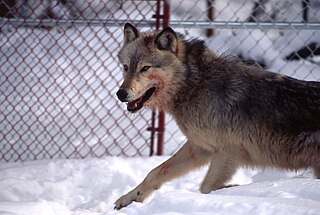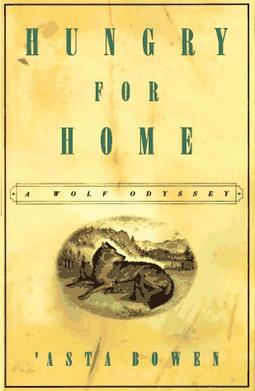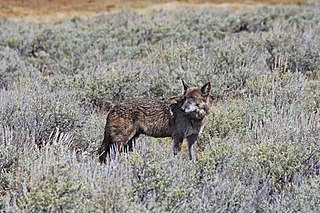Related Research Articles

Yellowstone National Park is a national park of the United States located in the northwest corner of Wyoming and extending into Montana and Idaho. It was established by the 42nd U.S. Congress with the Yellowstone National Park Protection Act and signed into law by President Ulysses S. Grant on March 1, 1872. Yellowstone was the first national park in the U.S. and is also widely held to be the first national park in the world. The park is known for its wildlife and its many geothermal features, especially the Old Faithful geyser, one of its most popular. While it represents many types of biomes, the subalpine forest is the most abundant. It is part of the South Central Rockies forests ecoregion.

White Fang is a novel by American author Jack London (1876–1916) about a wild wolfdog's journey to domestication in Yukon Territory and the Northwest Territories during the 1890s Klondike Gold Rush. First serialized in Outing magazine between May and October 1906, it was published in book form in October 1906. It is a companion novel to London's best-known work, The Call of the Wild (1903), which is about a kidnapped, domesticated dog embracing his wild ancestry to survive and thrive in the wild.
Geraldine Valerie Whelan, known by the pen name O. R. Melling, is a writer of fantasy novels, mostly for children and young adults. Melling's novels focus on Irish and Celtic folklore. She writes reviews and film scripts as G. V. Whelan. She is sometimes published as Orla Melling.
Alice Borchardt was an American writer of historical fiction, fantasy, and horror. She shared a childhood of storytelling in New Orleans with her sister, the novelist Anne Rice, who was two years younger. A nurse by profession, as a writer she nurtured a profound interest in little-known periods of history.
Maryanne Vollers is an American author, journalist and ghostwriter. Her first book, Ghosts of Mississippi, was a finalist in non-fiction for the 1995 National Book Award. Her many collaborations include the memoirs of Hillary Rodham Clinton, Dr. Jerri Nielsen, Sissy Spacek, Ashley Judd, and Billie Jean King. Her second book on domestic terrorism, Lone Wolf: Eric Rudolph – Murder, Myth, and the Pursuit of an American Outlaw, was published in 2006. A former editor at Rolling Stone she has written articles for publications such as Esquire, GQ, Sports Illustrated, Time,and The New York Times Magazine.

Wolf reintroduction involves the reintroduction of a portion of grey wolves in areas where native wolves have been extirpated. More than 30 subspecies of Canis lupus have been recognized, and grey wolves, as colloquially understood, comprise nondomestic/feral subspecies. Reintroduction is only considered where large tracts of suitable wilderness still exist and where certain prey species are abundant enough to support a predetermined wolf population.
Kathryn Lasky is an American children's writer who also writes for adults under the names Kathryn Lasky Knight and E. L. Swann. Her children's books include several Dear America books, The Royal Diaries books, Sugaring Time, The Night Journey, Wolves of the Beyond, and the Guardians of Ga'Hoole series. Her awards include Anne V. Zarrow Award for Young Readers' Literature, National Jewish Book Award, and Newbery Honor.
Karen Kay is the pen name for Karen Kay Wilson Elstner, an American author of historical romance novels. All of her novels feature Native Americans.
Anna Lee Waldo is an American historical fiction author. She is most noted for her novel Sacajawea.

The following articles relate to the history, geography, geology, flora, fauna, structures and recreation in Yellowstone National Park.

Wolf: The Journey Home, originally titled Hungry for Home: A Wolf Odyssey, is a 1997 American young adult novel written by 'Asta Bowen. Originally published by Simon & Schuster with line drawings by Jane Hart Meyer, it was retitled and reprinted without illustrations in 2006 by Bloomsbury Publishing. Based on true accounts of the Pleasant Valley, Montana, wolf pack, the novel traces the life of a female alpha wolf named Marta after the forced relocation of her pack in 1989 to an unfamiliar territory. Terrified, Marta abandons her pack and begins a journey in search of her home; she eventually arrives in Ninemile Valley, where she finds a new mate with whom she starts a new pack.

The history of wolves in Yellowstone includes the extirpation, absence and reintroduction of wild populations of the gray wolf to Yellowstone National Park and the Greater Yellowstone Ecosystem. When the park was created in 1872, wolf populations were already in decline in Montana, Wyoming and Idaho. The creation of the national park did not provide protection for wolves or other predators, and government predator control programs in the first decades of the 1900s essentially helped eliminate the gray wolf from Yellowstone. The last wolves were killed in Yellowstone in 1926. After that, sporadic reports of wolves still occurred, but scientists confirmed in the mid-1900s that sustainable gray wolf populations had been extirpated and were absent from Yellowstone as well as 48 states.

The northern Rocky Mountain wolf, also known as the northern Rocky Mountain timber wolf, is a subspecies of the gray wolf native to the northern Rocky Mountains. It is a light-colored, medium to large-sized subspecies with a narrow, flattened frontal bone. The subspecies was initially listed as Endangered on March 9, 1978, but had the classification removed in the year 2000 due to the effects of the Northern Rocky Mountain Wolf Recovery Plan. On August 6, 2010, the northern Rocky Mountain wolf was ordered to be returned under Endangered Species Act protections by U.S. District Judge Donald Molloy in a decision overturning a previous ruling by the U.S. Fish and Wildlife Service. They were later removed on August 31, 2012 from the list because of Idaho, Montana, and Wyoming meeting the population quotas for the species to be considered stable. This wolf is recognized as a subspecies of Canis lupus in the taxonomic authority Mammal Species of the World (2005).

The ecology of the Rocky Mountains is diverse due to the effects of a variety of environmental factors. The Rocky Mountains are the major mountain range in western North America, running from the far north of British Columbia in Canada to New Mexico in the southwestern United States, climbing from the Great Plains at or below 1,800 feet (550 m) to peaks of over 14,000 feet (4,300 m). Temperature and rainfall varies greatly also and thus the Rockies are home to a mixture of habitats including the alpine, subalpine and boreal habitats of the Northern Rocky Mountains in British Columbia and Alberta, the coniferous forests of Montana and Idaho, the wetlands and prairie where the Rockies meet the plains, a different mix of conifers on the Yellowstone Plateau in Wyoming, the montane forests of Utah, and in the high Rockies of Colorado and New Mexico, and finally the alpine tundra of the highest elevations.
Monte A. Dolack is an American graphic artist who lives in Missoula, Montana. Frommer's called him "one of the best-known artists in Montana." He works primarily in watercolor, acrylic paint, poster art, and lithographs. Dolack's work often features whimsical animals in both a natural and artificial setting, and has a worldwide following. Dolack is considered a key figure in the visual arts of the American West.
Gary Ferguson is an American writer. Ferguson is the author of more than 20 nonfiction books. His books have won awards from the Society of American Travel Writers, the High Plains Book Festival, and the Montana Book Award committee. His book Hawks Rest was the first book to be named Book of the Year by both the Pacific Northwest Booksellers Association and the Mountains and Plains booksellers association.
Thomas McNamee is an American writer and Guggenheim Fellow. He has written four nonfiction books in the field of natural history and conservation, as well as a novel. He has also written biographies of notable culinary figures Craig Claiborne and Alice Waters.

926F (Spitfire) (April 2011 – November 2018) was a wild wolf popular with visitors of Yellowstone National Park. She was killed about a mile outside the park boundary by a hunter when she crossed from the park into Montana, where the hunting of wolves was legal.

O-Six (2006–2012), also known as 832F or "The 06 Female", was a female gray wolf, whose death by hunting just outside the protected area of Yellowstone National Park stirred debate about the hunting and protection of wolves in Wyoming, Montana and Idaho. The bestselling book American Wolf focused on O-Six's life and on conservation policies in the Yellowstone region.
References
- ↑ Schelhaas, David (February 1994). "The Dangerous Safety of Fiction". The English Journal. 83 (2). National Council of Teachers of English: 51–55. doi:10.2307/821155. JSTOR 821155.
- ↑ "'Asta Bowen". writersontherange.org. Retrieved March 23, 2024.
- ↑ "Fiction Book Review: Hungry for Home: A Wolf Ody". Publishers Weekly. Retrieved June 16, 2021.
- ↑ Bowen, Asta (June 15, 2020). "Asta Bowen: Looking hate in the eye in Whitefish, Montana". The Salt Lake Tribune. Retrieved June 16, 2021.
- 1 2 Robisch, S. K. (2009). Wolves and the Wolf Myth in American Literature. Reno, Nevada: University of Nevada Press. OCLC 429685308.
- 1 2 3 Jones, Karen (May 2011). "Writing the Wolf: Canine Tales and North American Environmental-Literary Tradition". Environment and History. 17 (2). White Horse Press: 201–228. doi:10.3197/096734011X12997574042964.
- ↑ Kimball, Nancy (October 7, 2006). "Making the teen scene – in books". The Daily Inter Lake . Archived from the original on January 20, 2013. Retrieved April 29, 2010.
- ↑ "Nominations for the 2006 Teens' Top Ten Books" (PDF). American Library Association. 2006. Archived from the original (PDF) on June 2, 2006. Retrieved August 28, 2014.